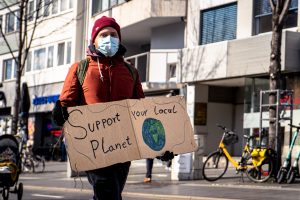summit
Even in Recovery, Hidden Pandemics Loom

As vaccinations are being adopted worldwide, businesses are opening up, and people are rushing out into life again, I, like many others, can see the light at the end of the tunnel. At this moment, I find myself reflecting and looking ahead to a future beyond the pandemic, one with plans and proposals for a more fulfilling and familiar version of life and work.
I’ve always been an optimist and have made my philanthropic choices based on this persistent focus on the possible. Most of my work to-date has been focused on building opportunity and equity through education — one might call it the most optimistic of all priorities, investing in generations to come. But even as I begin to imagine my personal life and opportunities post-pandemic, I can’t stop thinking about two hidden pandemics that are looming just beyond this joyful time of reopening, climate change and mental health.
I would argue that, instead of seeking to simply move on and in order to confront the challenges ahead, this is the very moment when we must maintain the pace and magnitude of investment that the pandemic inspired.
Climate Change:
By now, we all know the severity of issues stemming from our rapidly changing climate. One way or another, we have all been affected by them already. Storms will continue to get worse and more devastating, our communities will suffer from more frequent and destructive wildfires, sea levels will go up, and those with the least resources will be those who are most affected. We will run out of places for climate refugees. By mid-century, climate change could be just as deadly as COVID-19, and by 2100, it could be five times as deadly.
Mental Health:
The scope of the challenge presented by mental health issues is very complicated. Though often under-counted and misunderstood, the compound crises of the COVID-19 era have helped to expand a conversation that has been under-prioritized for far too long. Mental health struggles impact people of all ages in all places, from young moms in rural China, high school students in Silicon Valley, to people around the world who suffer from homelessness. What is perhaps most alarming about our evolving understanding of this silent pandemic is the high rate of depression and anxiety among our youth around the globe. Enlight Foundation’s pre-COVID mapping revealed that nearly one-third of youth had experienced depressive symptoms, and American youth now see anxiety and depression as more significant challenges than any other–including bullying, alcohol, drugs, and teenage pregnancy. Girls reported experiencing depression at three times the rate of boys, with 20% of teenage girls having experienced a major depressive episode. COVID-19 made the situation worse across all indicators.
Concurrent Crises:
Currently, at the federal level, the government spends quite a bit of money on research toward mental health; there is the will to confront climate change, but government actions are not entirely connected to what frontline providers say works. We need a long-term national plan for both of these looming crises.
In both the areas of climate change and mental health, there are terrific prevention and early intervention programs that are not yet funded to scale. We need to encourage investment in them, and to reform the way we invest in research. In short, we need to invest in supporting systems change.
We need to invest in youth and future generations. We need to invest in education to inform the climate and mental health space. For all its hardship, this is also a unique moment in history for transformative change. Our time to invest is now.
Despite the massive scope of the challenges before us, I remain optimistic. At the heart of my optimism is the fact that young people are at the front and center of the movements to take on these existential, universal threats. From the youth-driven Sunrise Movement that mobilizes young advocates for climate policy change to high schoolers providing peer-to-peer support programs for mental health prevention, the next generation is aware and activated.
There is so much we can do to protect and empower our children if we choose now to maintain our pandemic-level focus and energy. We need to share power with the young people who are in a position to make the greatest change over the longest term, honoring their work and their perspective—while funding their impact. There is so much to celebrate as we begin to see an end to the pandemic’s most acute global toll. (Though it is worth keeping in mind that we still have a long way to go and that recovery is taking many different forms and happening on many different timelines). As we celebrate, let us do so by turning our focus to the investments we need to protect against the looming impact of the hidden pandemics that are intertwined within our current investments. Our planet, and the next generation that will steward it, need us now.
